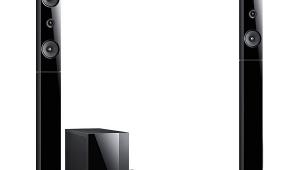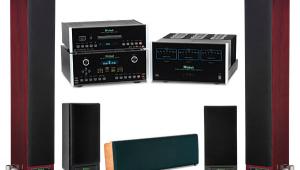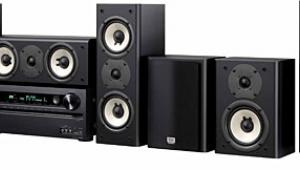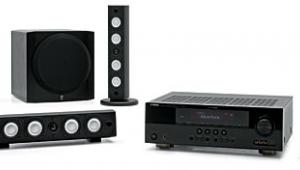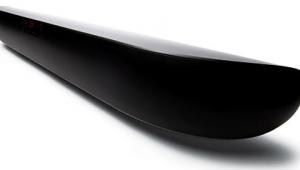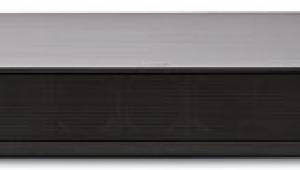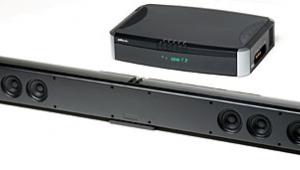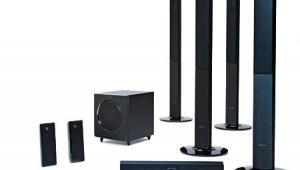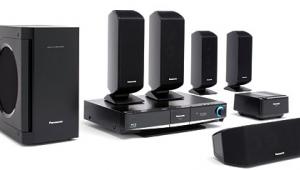Cambridge SoundWorks MegaTheater 505 HTIB Page 2

Sonically, I was impressed by the clarity and punch of the 505's soundfield. In the "Gabriel's Rescue" scene on the Patriot Superbit DVD, the DTS surround activity amid the rapidly changing camera angles and cacophony of gunshots and voices was spot-on, having all of the impact that I expect from one of my favorite show-off scenes. Similarly, the system supported the aggressive use of all of the full-range channels in Star Wars: Episode II—Attack of the Clones well, although the little MC50s tend to crowd the highest-frequency signals. The low end is adequate for most needs, with particularly effective ambient bass throughout movies. Even when the subwoofer is turned up and system power is at maximum volume, though, peak activity (such as big explosions) comes up short. If you're expecting to set those love handles a-jiggling with killer bass, that's just not going to happen with this system. Stereo music, meanwhile—from CDs, HDCDs, and MP3s—is warm, accurate, and extremely enjoyable at a moderate volume.
 Video quality is outstanding, even on demanding material like the state-of-the-art Clones. The 505 rendered this disc beautifully on every level except the blacks, which tend to be slightly murky and lack shadow detail. The 3:2-pulldown correction left only mild flickering on Faroudja's Sage demo disc, which I use for progressive-scan evaluation. The player's so-so luma/chroma separation introduced faint rainbow effects in the fine black-and-white line test pattern. The 505 performed much better with real material, be it test photos or actual movie clips, and it did a great job of eliminating most artifacts, creating smooth, natural edges and introducing little to no feathering during difficult-to-reproduce video text over film.
Video quality is outstanding, even on demanding material like the state-of-the-art Clones. The 505 rendered this disc beautifully on every level except the blacks, which tend to be slightly murky and lack shadow detail. The 3:2-pulldown correction left only mild flickering on Faroudja's Sage demo disc, which I use for progressive-scan evaluation. The player's so-so luma/chroma separation introduced faint rainbow effects in the fine black-and-white line test pattern. The 505 performed much better with real material, be it test photos or actual movie clips, and it did a great job of eliminating most artifacts, creating smooth, natural edges and introducing little to no feathering during difficult-to-reproduce video text over film.
The setup menu offers a surprisingly sophisticated array of picture-mode options for progressive-scan playback. The auto mode uses bob or weave technology based on the embedded flags in the program material, the film mode uses only weave for superior resolution, and the video mode uses only bob, which is better at eliminating artifacts. The smart mode, meanwhile, selects bob with added vertical filtering for a softer picture. Best of all, the 505 arrives in the default Super Smart mode, which utilizes automatic, flag-based bob or weave for starters, then kicks in with motion-adaptive deinterlacing that switches to bob (plus the vertical filtering) in motion-intensive frames and weave in still frames. The Super Smart mode is the best of all possible worlds, and it's probably all you'll ever want to use.
Like the rest of this package, the graceful, gray all-in-one remote is extremely elegant. It represents yet another new layout to learn, but the many well-thought-out buttons are sculpted so as to be easily identifiable. Another advantage of the video source and preamp sharing a single chassis is the availability of handy information like master system volume right up there on the TV screen.
I can heartily recommend this budget selection from the inaugural MegaTheater lineup as an above-average contender in the HTIB category. Of course, by its designers' very intent, there is, quite literally, room for improvement.
HIGHLIGHTS
• Progressive-scan video output, with necessary cables included
• Complemented by better-than-average Newton Series speakers

